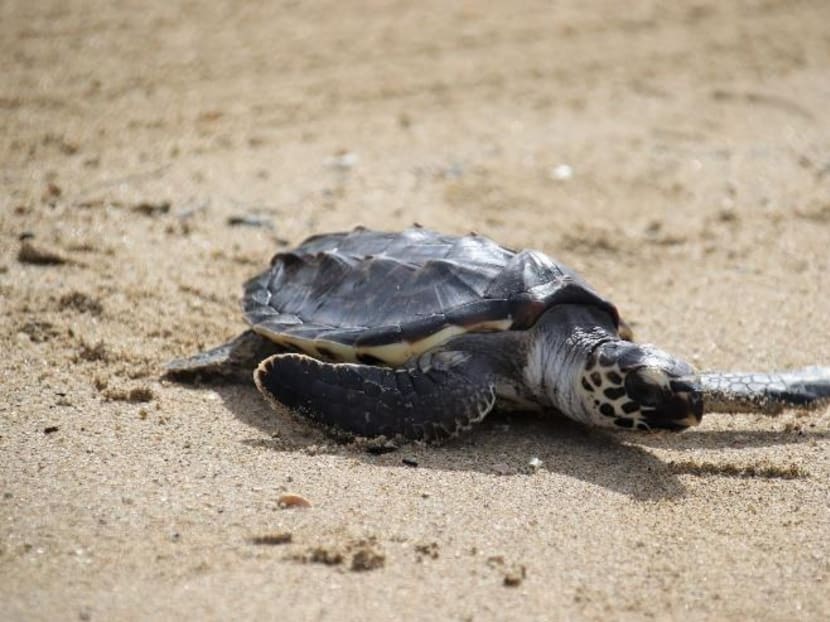Hawksbill turtle rescued from brink of death released back into the wild
SINGAPORE – It was barely alive and severely dehydrated when found inside a ruptured egg on one of the Southern Islands last September.

After veterinary checks on Jan 3 indicated it was in the pink of health, the National Parks Board and Wildlife Reserves Singapore decided to return the Hawksbill Sea Turtle to the wild. Photo: Wildlife Reserves Singapore
SINGAPORE – It was barely alive and severely dehydrated when found inside a ruptured egg on one of the Southern Islands last September.
The premature Hawksbill Sea Turtle hatchling was handed by the National Parks Board (NParks) to Wildlife Reserves Singapore (WRS), which provided it with critical care overnight and cared for it over four months.
From 10 grams when it hatched, the turtle has grown to 500 grams.
This week, it was released into the waters of Sisters’ Islands Marine Park, NParks and WRS announced on Friday (Jan 26).
The release comes as Singapore’s shores record more sightings of the critically endangered species. There were 18 sightings of Hawksbill Sea Turtles last year alone, compared to 43 sightings reported between 2011 and 2016.
The sightings include arrivals, nests and hatchlings. Last year, more than 500 successful hatchlings from seven separate nests were recorded.
The increased sightings follow the initiation of a systematic monitoring programme and an increase in reports from members of the public arising from heightened awareness, said NParks’ Dr Karenne Tun, director of the National Biodiversity Centre (Coastal & Marine).
The team from the Marine Turtle Working Group, which includes NParks and WRS, is cautiously optimistic about the rescued hatchling’s chances of survival but noted challenges it faces. Sea turtles, especially juveniles, face predation and other natural threats, as well as plastic debris and other impacts of human activity.
When NParks first found the recued hatchling, it was premature and still had its yolk sac attached to the body.
After it was given fluids and critical care by WRS staff, it emerged from the egg the next morning. Over the next few days, it was given fluid supplements until it had fully absorbed its yolk sac.
The turtle was later transferred to bigger tanks as it grew and readily ate a variety of solid foods, including mussel, flower crab, shrimp, squid and fish, said NParks and WRS. Live rocks, which have living organisms on them, were also provided as an essential part of the sea turtle’s diet.
After veterinary checks on Jan 3 indicated it was in the pink of health, the team decided to return it to the wild as soon as possible.
The turtle has also been microchipped, allowing it to be identified if it returns to Singapore’s shores in future.
When it was released on the beach, it scurried into the sea and swam around the shallow lagoon waters before making its way slowly towards the mouth of the lagoon.
After navigating past a ring of Sargassum seaweed fringing the reef outside the lagoon, the turtle descended to the shallow reef slope for a short rest before swimming out to sea, said NParks and WRS on Friday (Jan 26).
The knowledge gained from the rescue and rehabilitation of this hatchling will contribute to the team’s understanding of the species and help guide conservation efforts, added the spokesperson.
Singapore has two recorded species of turtles, the endangered Green Turtle and the Hawksbill Sea Turtle, which is the more common species found in local waters.
Marine turtles have been sighted along East and West Coast Parks, Changi Beach and the offshore islands, said Dr Tun.
“We believe that turtles have always been nesting on our shores,” she added.
Members of the public who spot a turtle can contact the NParks helpline at 1800 471 7300.
Humans should keep their distance and speak softly. They should avoid touching the turtle to avoid scaring or provoking it. They should not handle the eggs to avoid damaging them.






